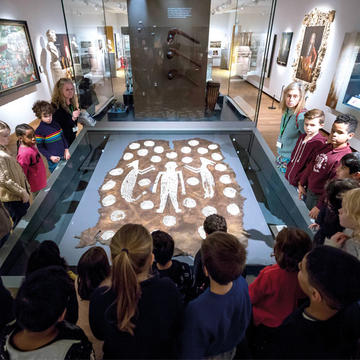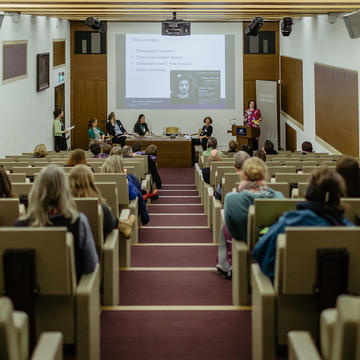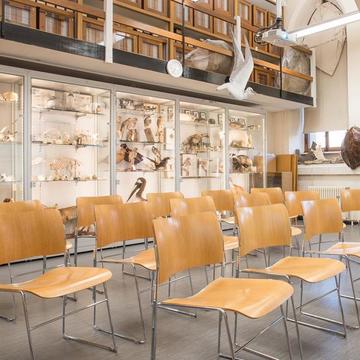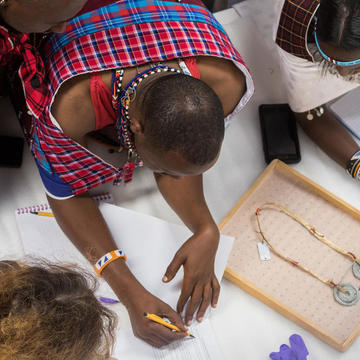Debates and discussions
Many of Oxford University’s Gardens, Libraries and Museums (GLAM) have lecture theatres, particular galleries or spaces within the institution which can be used to host debates and discussions.
Panel discussions can complement particular exhibitions or displays or can focus on any aspect of the GLAM collections. They can be tailored toward a specific audience or open to the general public, allowing the researcher to engage with target groups.
Debates and discussions can also take place online and/or livestreaming may be available, hosted by the GLAM institution. Depending on the venue, talks may be saved as podcasts for posterity. See the Online engagement section in the GLAM PCER Toolkit for further information.
Costs can be variable, particularly if extras are required (e.g. drinks reception) – contact the relevant team to discuss.
In-person events often take place once the institution has closed for the day and may therefore incur additional staffing costs.
Events may be planned up to a year in advance therefore it is advisable to contact the relevant team at the institution at the earliest possible convenience. Please be aware that GLAM venues have full and busy programmes and it may not be possible to pick up activities that have already been fully developed or to deal with urgent requests. Ideally, activities should be co-created with GLAM from project conception and researchers should get in contact early so that we can work together to develop your ideas. Please note that while researchers may contact GLAM departments directly they are also encouraged to contact departmental/Divisional PCER facilitators for interim support/guidance.

GLAM PCER Toolkit | Getting started |
| Opportunities by category | Opportunities by institution | Case studies |
(Please note that opportunities are subject to change)
- Debates and discussions can be a means of raising public awareness about a particular topic and creating meaningful dialogue between researchers and audiences (although can also be ‘preaching to the converted’, depending on the nature of the audience)
- Participatory dialogue events can be a means of eliciting public feedback on research as well as disseminating researchers' projects
- For the activity to be meaningful it is important to capture the feedback and discussion points and do something useful with it after the event. Debates and discussions without meaningful audience engagement may otherwise be at more of the ‘one-way’ end of the spectrum of public and community engagement with research (PCER)
- Presenting multiple viewpoints can better represent and engage diverse audiences, and engaging with controversy can help to ensure that programmes are dynamic and relevant
- Debates and discussions can be long-duration and deep-level engagements so there is a lot of potential for learning (in comparison to other lighter touch activities). Also with such events the audience often consists of people who already have an interest in the subject meaning that they’re more motivated to learn (in comparison to other drop-in activities); as a result, this activity is less suitable for reaching new audiences
- The level of debate/discussion needs to be carefully pitched to ensure it is accessible to the expected audience
- For debate-style events, the advertising needs to be clear as to the level of audience involvement within the debate, otherwise this format has the potential to be disempowering for the audience instead
- The delivery of out-of-hours events leads to reliance of variable hours staff to provide cover, which needs to be considered as it is a defined resource. As well as being costed in to the activity, planning and long lead periods need to be observed to avoid any clashes
List of considerations adapted from UCL Engagement's 'Putting on a public event'
Costs may be variable but are usually one-off costs:
- Collaborator costs – expenses may apply for other speakers for a panel
- Curatorial staff time if required, although if the researcher is the speaker then the public engagement or events teams would most likely manage everything else. See section on How much will the PCER activity cost? in the GLAM PCER Toolkit for further details
- Staffing, e.g. front of house, public engagement, technical services support – although may be given ‘in-kind’. See section on How much will the PCER activity cost? in the GLAM PCER Toolkit for further details
- Event costs, e.g. orientation signage, design of print materials, catering (drinks/food)
- Marketing, e.g. incl. print costs, advertising, press/PR – may be covered via regular GLAM channels
- Evaluation costs, e.g. Evaluation Officer time, survey costs (tablet or paper surveys)
- Film & photography
- AV and other equipment hire beyond that provided by the GLAM institution and/or the researcher
- Venue hire – may be given in-kind
Note that this is not an exhaustive list and that these types of activities may incur costs not listed here.
Please contact the relevant team to discuss costs as soon as possible.
Additional information and links

Ashmolean Museum
Potential venues (capacities): Headley Lecture Theatre (100 seated theatre-style) | Galleries (capacity depends on space) | Other options may be available
Further information: Ashmolean Museum venue hire webpage
Examples: Ashmolean Museum events webpage
Ashmolean PCER projects are currently being updated. Examples and opportunities are subject to change.
Contact: PER Coordinator, Zoe Bampton (zoe.bampton@ashmus.ox.ac.uk)

Bodleian Libraries
Potential venues (capacities): Weston Library Lecture Theatre (117 seated) | Other options may be available
Further information: Bodleian Libraries venue hire webpage
Example: Spiritual Physic: From despair to hope with the Anatomy of Melancholy
Further examples: Bodleian Libraries exhibitions and events webpage
Contact: Public Engagement team (publicengagement@bodleian.ox.ac.uk)

History of Science Museum
Potential venues (capacities): tbc
Further information: History of Science Museum venue hire webpage
Contact: Public Engagement Office (publicengagement@hsm.ox.ac.uk)

Oxford Botanic Garden & Arboretum
Potential venues (capacities): Daubeny Laboratory can be hired from Magdalen College (50 seated) | Conservatory (30-35 people for a talk or lecture) | Other options may be available
Further information: Oxford Botanic Garden venue hire webpage
Example: Celebrating Botanic Gardens: Past, Present and Future
Further examples: Oxford Botanic Garden what’s on webpage
Contact: Events team (events@obg.ox.ac.uk)

Oxford University Museum of Natural History
Potential venues for talks (capacities): Lecture Theatre (300 seated) | Annexe (50 seated) | Seminar Room (40 seated) | Other spaces may be available
Further information: Museum of Natural History venue hire webpage
Example: The Great Debate; Should We Engineer Our Way Out of Climate Change?
Further examples: Museum of Natural History events webpage
Contact: Education team (education@oum.ox.ac.uk

Pitt Rivers Museum
Potential venues (capacities): Lecture Room (60 seated) | Balfour Room (50 seated) | Beatrice Blackwood Seminar Room (25 seated) | Other options may be available
Further information: Pitt Rivers Museum venue hire webpage
Example: Radical Hope, Critical Change
Further examples: Pitt Rivers Museum events webpage
Contact the museum for more information (prm@prm.ox.ac.uk)




